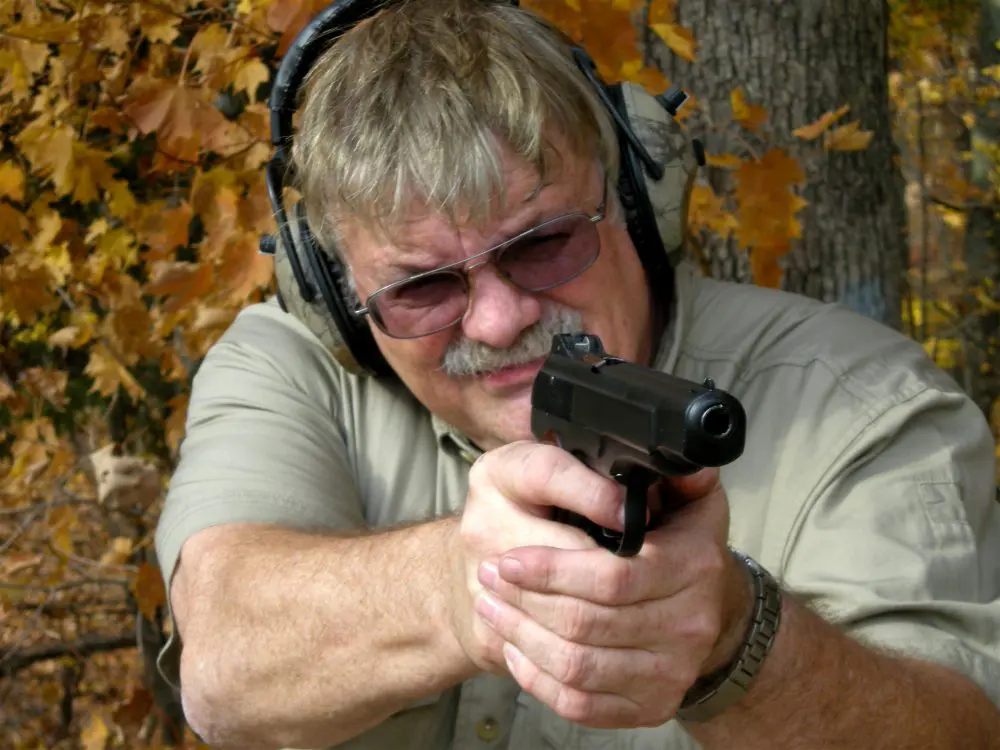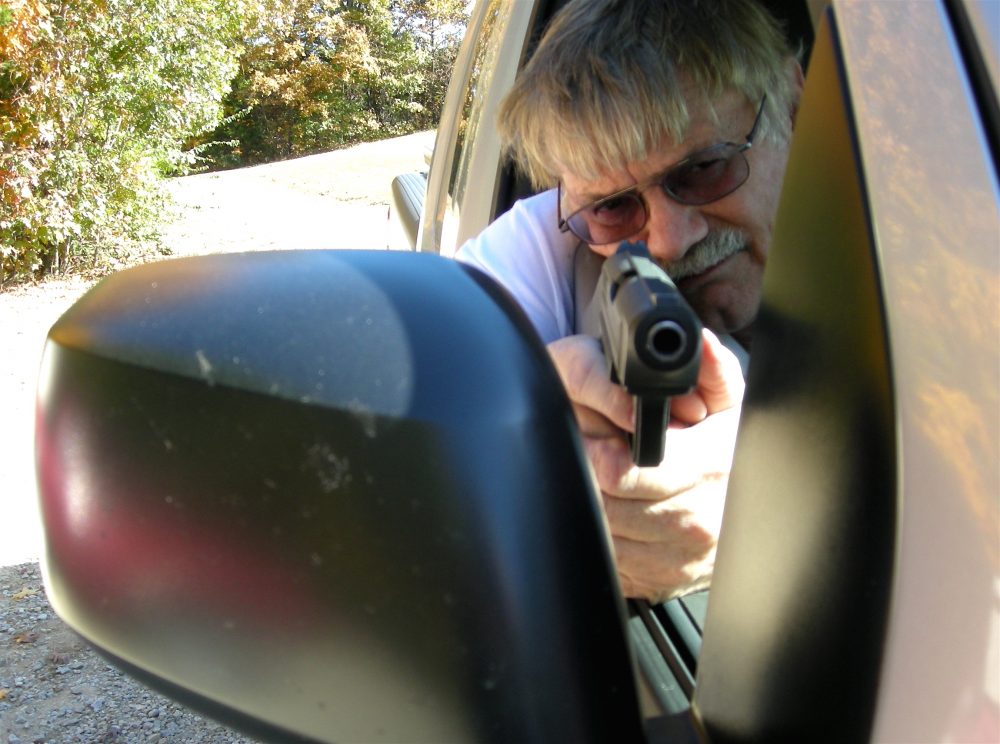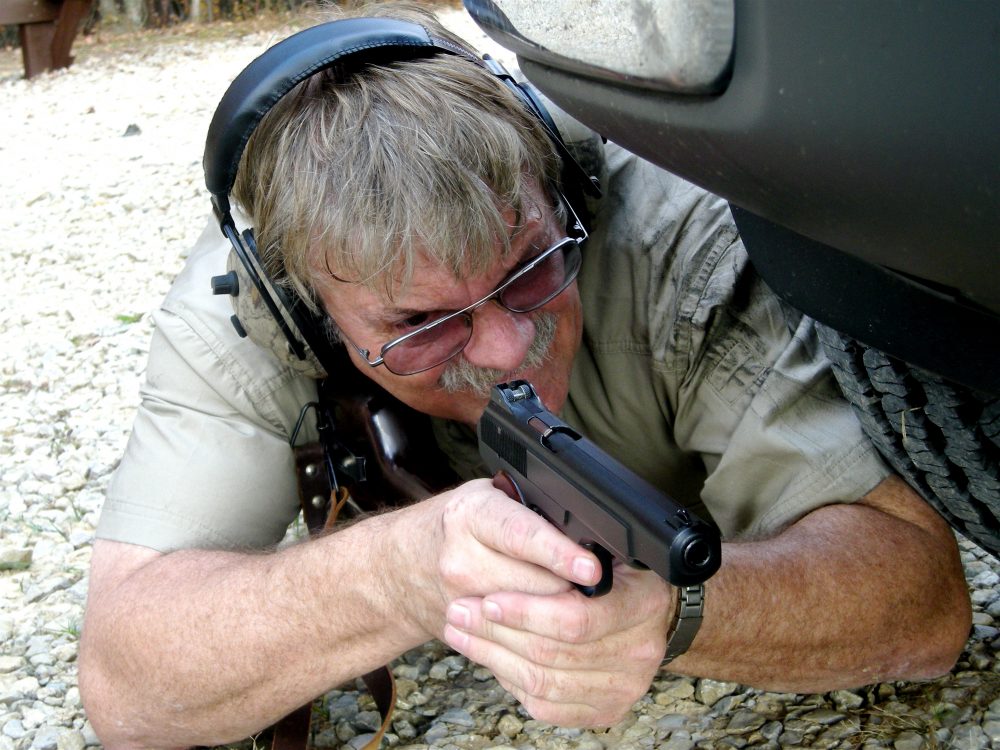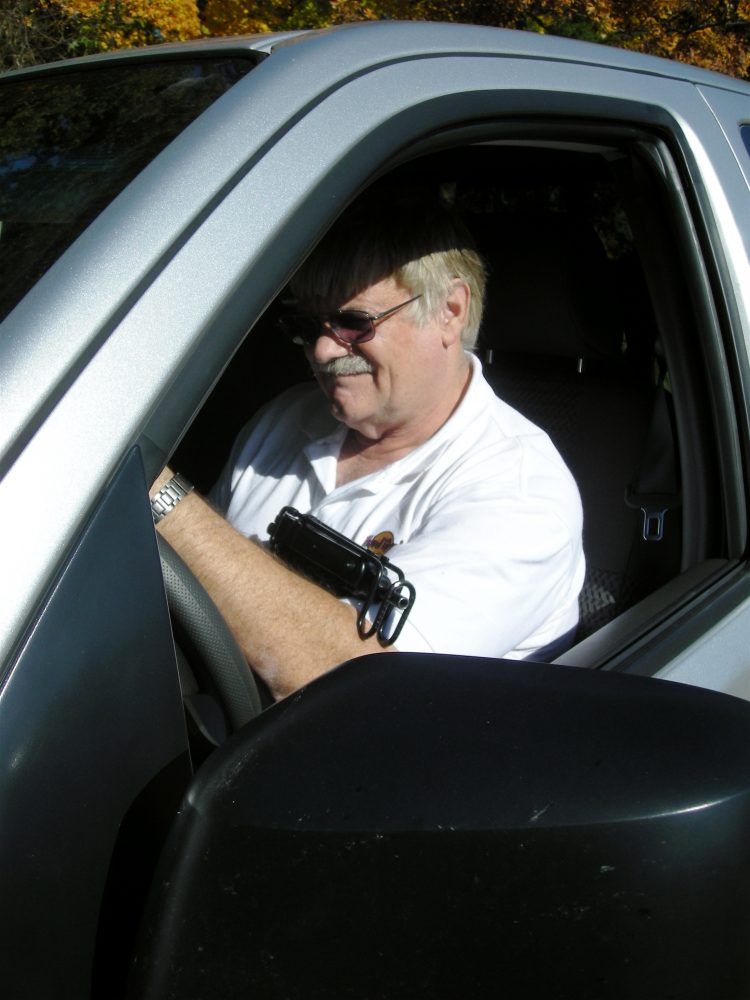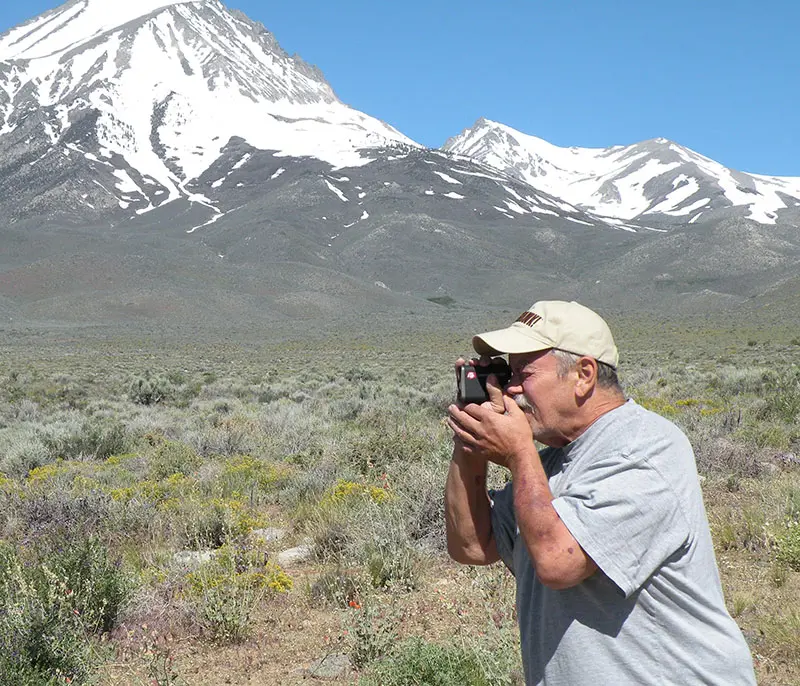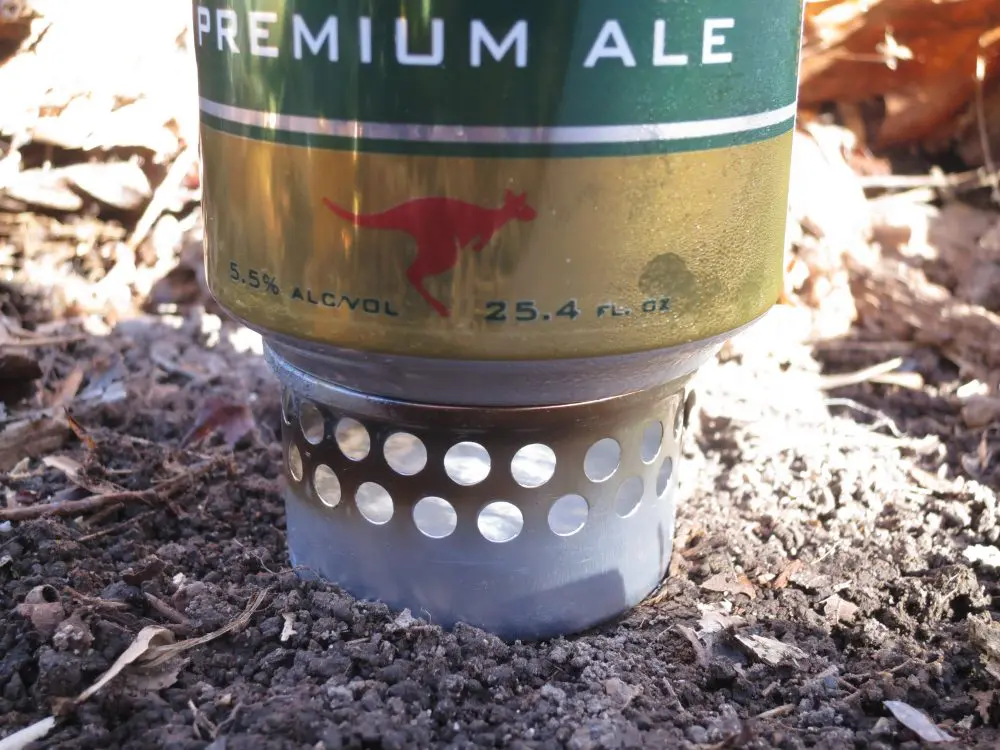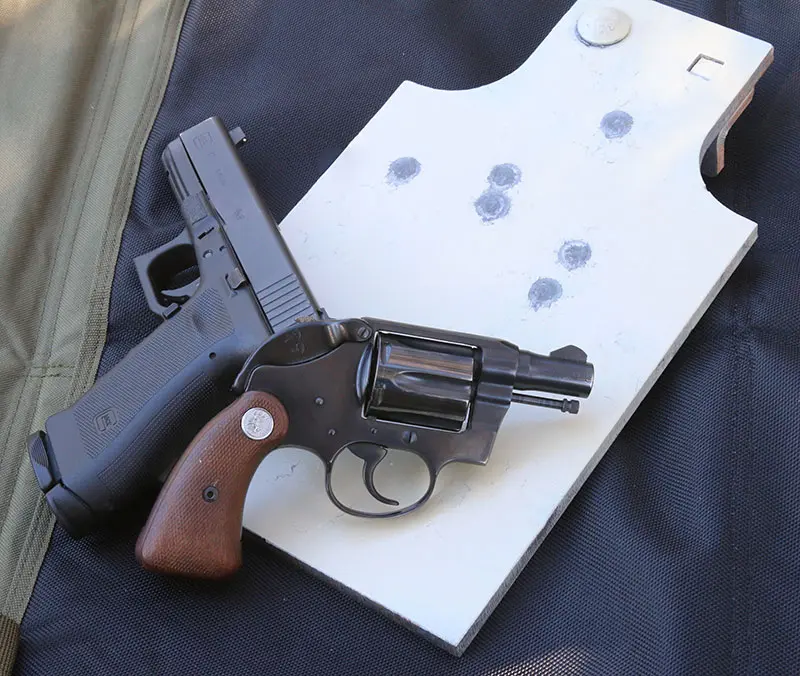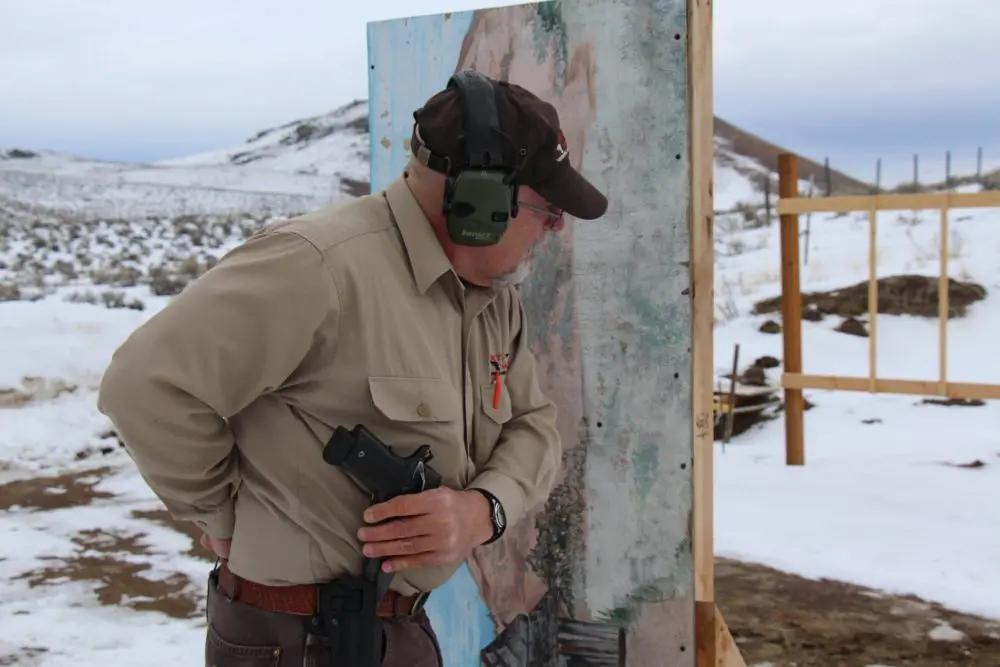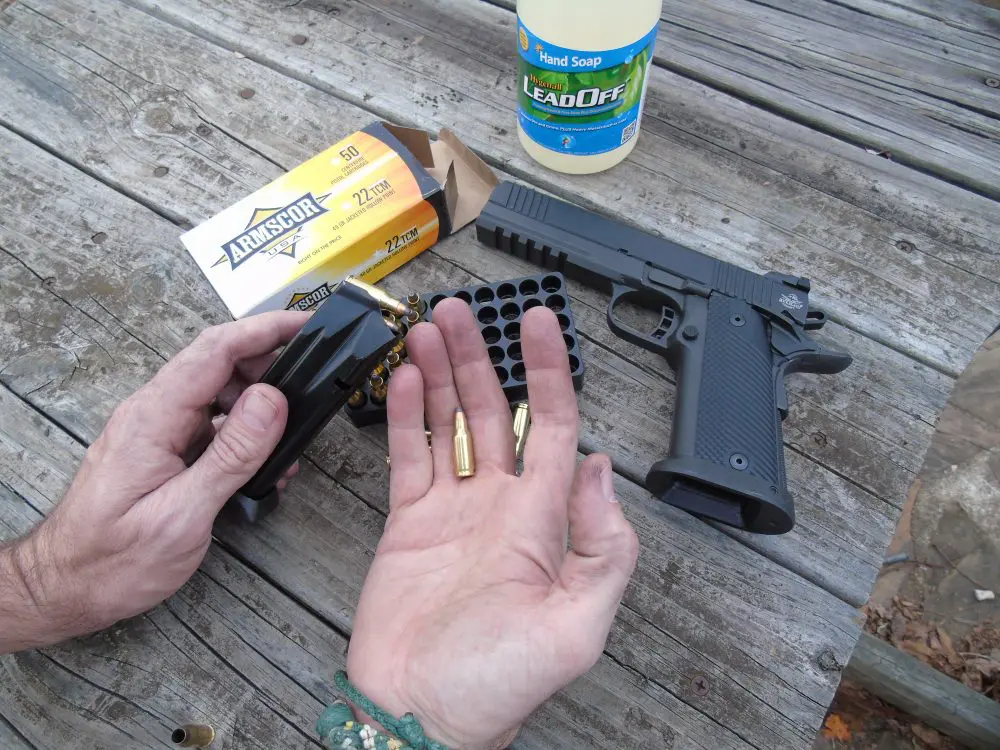I’ve always been rather ambivalent about the machine pistol. First, let me clarify that I do not use the term “machine pistol” in the German sense, which gives the “MP” designation for submachine guns. I use it to refer to those select-fire pistols that pose as submachine guns, or maybe it’s submachine guns that pose as pistols! In either case, they’re not really an American weapon, and I have serious questions about their usefulness. On the other hand, I shoot them quite a bit because over the years, I have trained many close protection units that deployed them. In any case, I thought a discussion of the machine pistol might be of interest to S.W.A.T. readers.
Machine pistol lends itself well to usage from within a vehicle, since it is quite handy.
Table of Contents
MAUSER SCHNELLFEUER
This will not be a comprehensive history of the machine pistol. I’m sure there will be some I don’t mention. The first one I encountered was the Mauser Schnellfeuer. The Schnellfeuer was a select-fire version of the Mauser 1896 “Broomhandle” that was introduced in 1932 and took a 10- or 20-round detachable magazine. The Spaniards had actually made a select-fire copy of the C96 in the late 1920s for export to China (hence the “C” designation). In China, they made an enlarged select-fire version of the C96 in .45 ACP, which was designated the Shansi.
I have seen the Schnellfeuer a few times, most oddly among some reserve officers with a sheriff’s department I worked for 40 years ago. I got to know this machine pistol better when I trained a group of Latin American VIP drivers who carried the Astra version across their laps while chauffeuring their Oligarch around.
As with many machine pistols, the C96 Mauser had a holster stock that could be affixed to the pistol to make it more controllable. This, along with the pistol caliber, is one of the more common characteristics of the machine pistol. However, while many have holster stocks, not all do.
CZECH SKORPION
The machine pistol I used a lot for a few years was the Czech Skorpion—the choice of terrorists in many parts of the world.
I was contracted to do a course for mixed government and civilian personnel who were deploying to troubled—let me make that TROUBLED—places. I gave the usual hints for not making themselves targets, basic suggestions on hardening their residence and lifestyle, observation exercises to determine if they were being surveilled, etc. I followed this up with very basic self-defense tactics—quick and dirty unarmed close combat, use of the blade, and use of improvised weapons.
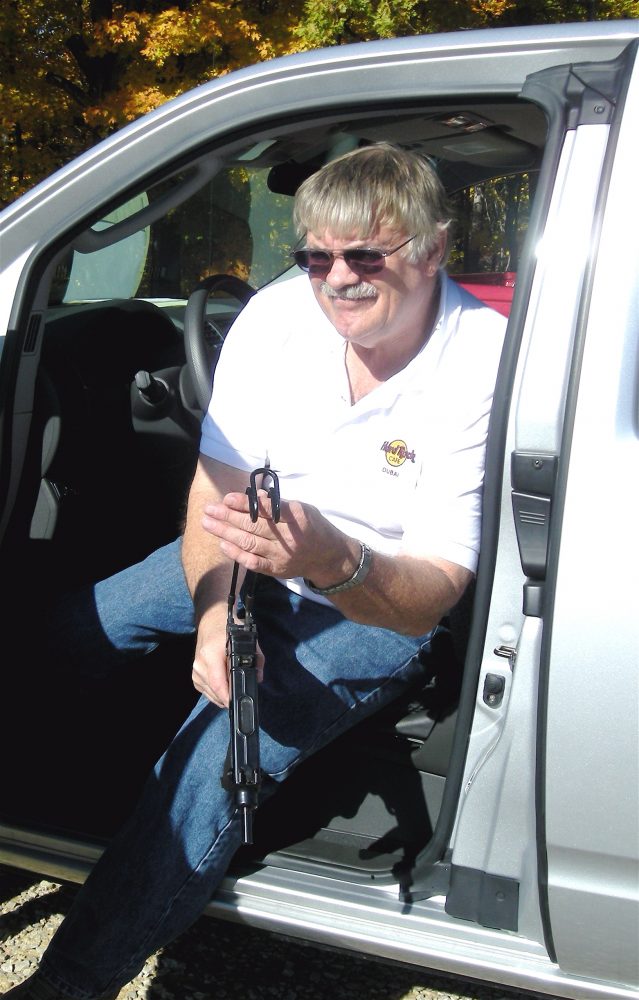
I also taught disarming techniques against armed kidnappers/assailants. These included recognizing if the weapon’s safety was on or off—easy to teach on AKs; on some others, not so much! For more hardcorp classes, we sometimes taught how to stick the fingers in front of a cocked hammer to block it, or how to push the slide back or grab the cylinder of a revolver to render the weapon less likely to function.
The primary object of the drill was to take the weapon and turn it on the attacker. This required that the trainees, many of whom had no firearms expertise, learn how to use half a dozen or more firearms commonly encountered with terrorists. One that I always tried to have available was the Skorpion.
The Skorpion Machine Pistol is often known by its designation Vz61 and is most commonly found in 7.65x17mm (.32 ACP) chambering. Reportedly, the Skorpion was also made in .380 (9x17mm Short), 9x18mm Makarov, and 9x19mm Parabellum. Each of those has a different Vz designation. I believe I handled one in 9x18mm in Africa, but I am not positive. Otherwise, my experience has always been with the .32 ACP version. There is also a version made in Yugoslavia designated the M84. I have fired this model made by Zastava and found it of good quality.
The Skorpion is designed to be carried in a standard belt holster on steroids rather than a holster stock. The Skorpion’s stock folds along the top of the receiver. To fit in the holster, the short 10-round magazine must be carried in the weapon. There is also a 20-round magazine available. The sights are fairly rudimentary, comprising a front post and flip-up rear. When carried for use as a pistol, the overall length of the Skorpion is 10.6 inches. With the stock extended, overall length is 20.4 inches. With practice, one can deploy the stock quickly with a slap. Barrel length is 4.5 inches. At 45 ounces, the Skorpion is heavy for a .32 ACP weapon.
On the positive side, the Skorpion is very easy to control on full-auto due to the light recoil of the .32 ACP round. Suppressed versions can be effective, though the standard Czech suppressor that I’ve used on Skorpions is not particularly good. The major problem with the Skorpion is that it is too much gun for too little performance. Given my choice, I would take a more compact 9x19mm semi-auto with a high-capacity magazine any time.
The Skorpion was always popular with Third World assassins, who rode on the backs of Vespas or other scooters and hosed down a target vehicle at point-blank range as they passed. My attitude was that if I had to face one of them, I would rather see him armed with a Skorpion than something more effective!
Stechkin works as a large-capacity (20 rounds) handgun or even used on full-auto without the shoulder stock, though it is more effective with the stock.
HK VP70
The original “plastic pistol” was a machine pistol. The polymer HK VP70 was a high-capacity, double-action only pistol that became a machine pistol capable of three-shot bursts when its holster stock was affixed. It was produced from 1968 to 1989. The VP70 held 18 rounds of 9x19mm ammunition at a time when there were few high-capacity autos. This made it somewhat popular in the semi-auto version (the Z version), which did not have select-fire capability. At eight inches overall length and 29 ounces empty, it was not unduly large, though I always found the grip uncomfortable.
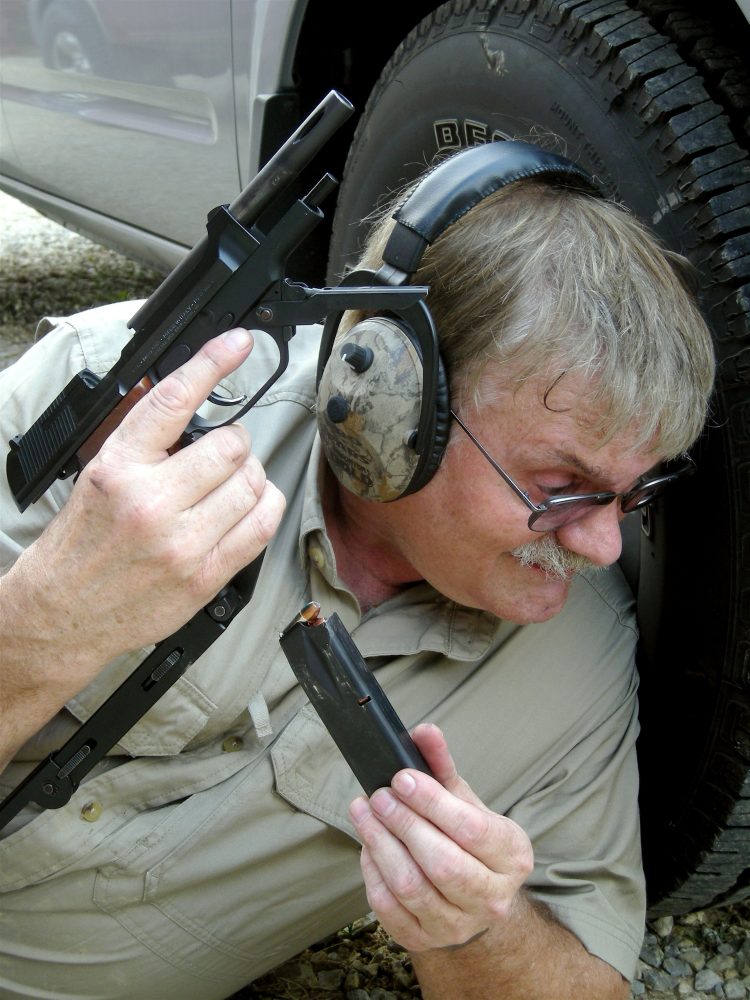
In the M (Military) version, the VP70 came with the holster stock and a harness system that allowed the pistol to be carried across the chest in the ready position. The holster stock looks more like a stock than a holster and has some protrusions that can catch on things. Small parts that protrude from the stock as part of the burst-fire mechanism can also be damaged when carrying the pistol in the holster stock.
The VP70 is probably my least favorite of the machine pistols, as I find it overly complicated and impractical. On the positive side, it could be carried as a high-capacity pistol without the select-fire capability, though I found the DA-only pull quite heavy. Trigger pull made accurate three-shot bursts past ten yards or so difficult for me as well. Back in the day, I worked with an occasional foreign police agency that had some VP70s. If I had my choice between using the VP70, in either Z or M version, or my Browning Hi-Power, I chose the Hi-Power.
Speaking of the Hi-Power, I have fired some machine pistol versions, though to the best of my knowledge, the P35 was never offered commercially as a machine pistol. The conversions were based on Hi-Powers that had holster stocks and were relatively controllable with the stock affixed if the shooter leaned well into the pistol. They emptied fast with standard 13-round magazines (14 for Inglis) and even with 20-round Mec-Gar samples. But I could shoot the “Rock-and-Roll” Hi-Power relatively well at ten yards or less.
BERETTA 93R
The Beretta 93R is an interesting machine pistol with which I’ve had a bit of experience since its introduction in 1977. The “R” in the designation stands for Raffica, which means “burst” in Italian. And three-shot bursts are what the 93R fires when the selector is set for bursts. The 93R does not have a holster stock, but instead employs a leather holster that carries the pistol, as well as a skeleton stock that can be affixed to the pistol.
The stock aids in controlling the pistol, but the 93R incorporates some other features which make it easier to shoot on burst than many other machine pistols. It has a muzzle brake and a foregrip that folds down for usage. The proper technique for use is to insert the support-hand thumb around the trigger guard and grip the foregrip with the rest of the fingers. At close range, this allows reasonable control even without the stock affixed.
Although the 93R shares many characteristics with the Beretta 92, including the high-cap magazine, it is a single-action pistol when used in the semi-auto mode. It will take standard Beretta 92 magazines, but a 20-round magazine is the choice for use on burst mode. When I used to work on security details where we had Beretta 92s, we would try to grab at least one 93R 20-round mag to carry as a spare for breaking ambushes.
I actually like the 93R fairly well and didn’t mind when we had it on North African security details, though when a Beretta M12 SMG was available, I usually grabbed it. In fact, coming back from a North African gig many years ago, a friend and I were in Leonardo Da Vinci Airport in Rome waiting for our flights when we noticed some Italian airport police (I think they were Polizia di Stato) armed with 93Rs. This was a time when terrorist attacks on airports were all too common, so we started looking for solid cover in case the Polizia had to open up with three-shot bursts—we were not confident of their precision shooting ability!
Practicing engagement from behind cover with Stechkin, stock attached.
SOVIET STECHKIN APS
Now we come to my favorite machine pistol, which I have to admit comes from the old Evil Empire. The Soviet Stechkin APS (Avtomaticheskiy Pistolet Stechkina) was introduced in 1951 along with the Makarov, both in 9x18mm caliber. The 9mm Makarov chambering offers more power than a .380 and less recoil than a 9x19mm round, which lends itself well to use in a machine pistol.
The Stechkin has a holster stock similar to that of the Broomhandle Mauser in that it is wood and allows the butt of the pistol to stick out when the lid of the holster is closed. It’s not a great holster, but it is functional and does work fairly well as a stock. The size of the Stechkin isn’t bad, at 8.9 inches overall and a bit over 40 ounces. The 5.5-inch barrel lets the 9x18mm round build up a bit of velocity. Magazine capacity is 20 rounds.
I had fired Stechkins on foreign weapons familiarization courses, but I really became interested in this machine pistol through a former KGB bodyguard I knew in Brussels. I was there working with a European Economic Community security team, and he was there working with a Russian arms dealer demonstrating weapons.
His personal weapon when he had guarded high-ranking officials had been a Stechkin, which he had carried in a shoulder rig with two spare magazines under the opposite arm. He primarily used the Stechkin as a high-capacity semi-auto; however, he and his colleagues practiced using it on full-auto to break ambushes if needed.
He demonstrated to me that he could lean into the stockless Stechkin and keep all his rounds fired in four- to five-round bursts on a silhouette target at ten yards. With the stock affixed, he shot very tight groups. I should note that he was about 6 feet tall, weighed 225 lbs, lifted weights and practiced Sistema.
I became fairly proficient with the Stechkin and could consistently keep a full mag on the silhouette firing bursts with the stock affixed. If I really leaned into the gun and fired the shortest bursts I could, I did fairly well without the stock as well. I have also done quite a bit of shooting with the Stechkin on semi-auto and have found it no better or worse than some other self-loaders. The sights are acceptable but not great.
The AKSU pretty much replaced the Stechkin for most uses, but some Spetsnaz units continued to use the Stechkin APB, which has a skeleton stock and a suppressor. Some of my contacts have told me that FSB Alfa (Russian anti-terror unit) still has some APB versions for aircraft assaults. I have also seen APB Stechkins with at least one Delfin unit (Russian combat swimmers).
I think the Stechkin is the best of the typical European machine pistols. Some of my Russian special ops contacts who are pretty sharp on their weapons like it as well.
POLISH PM-63
One other machine pistol from the Cold War era merits mention, though it could also qualify as an SMG. The Polish PM-63 is a little over 13 inches overall with stock retracted, but it does carry in a holster and could be called a large machine pistol. Its 25- or 40-round magazines protrude from the butt quite a bit, which makes carry in the holster with magazine in place problematical.
Czech Skorpion and other machine pistols have been popular with some VIP drivers. Unfortunately, to have some capability of bringing the weapon into action quickly, it cannot be carried in the holster.
GLOCK 18
The one current machine pistol that sees some usage is the Glock 18. Basically a Glock 17 with a selector switch on the slide, the Glock 18 can be carried in standard Glock holsters. In fact, unless one notices the selector switch, it is easy to mistake a Glock 18 for a Glock 17.
A sheriff’s department near St. Louis had a Glock 18 in their armory. A friend of mine was there one day when he noticed a new female deputy carrying the Glock machine pistol in her duty rig. It turns out that she had a Glock on order, and they’d given her the Glock 18 to carry until hers came in. No one had bothered to tell her that if she flicked that little selector, she’d have a small full-auto weapon in her hands! I’m not sure anyone involved realized what a Glock 18 is.
I’ve done a reasonable amount of shooting with the Glock 18. The polymer frame absorbs recoil relatively well in full-auto fire, which makes it possible to lean into the 18 and control it when firing bursts. No shoulder stock is furnished, but there are aftermarket ones available, which help in shooting the Glock 18. Note that one cannot just use one of these stocks with a Glock 17, 22, etc. without registering the pistol as a short-barreled rifle, but since the Glock 18 is already an NFA weapon, the stocks may be used.
The advantage of the Glock 18 is that it may be carried and used as a standard semi-auto pistol. If the select-fire feature is required, the user just flicks the lever and is ready to rock and roll. An extended magazine is available that holds 31 rounds to give more capacity for full-auto fire. I definitely recommend that anyone employing a Glock 18 practice a lot—really, really a lot—in order to control it on full-auto.
WORTHY?
As you may have concluded, I don’t consider most machine pistols much more effective than a good high-capacity semi-auto pistol. When I trained protective teams that had machine pistols, the machine pistols were reasonably good for use from within a vehicle or for issue to VIP drivers to give them a marginally more effective weapon during an evacuation under fire.
Most of the security teams I’m familiar with that had used machine pistols have switched to other weapons. In some cases, they’ve gone to full-sized SMGs or carbines, but some have adopted the PDW, especially the FN P90 for missions formerly assigned to the machine pistol.
For the most part, outside of highly specialized units, the machine pistol never gained widespread acceptance. Hard to control in full-auto fire, there is nothing that a machine pistol can do that other weapons available today can do more efficiently.
